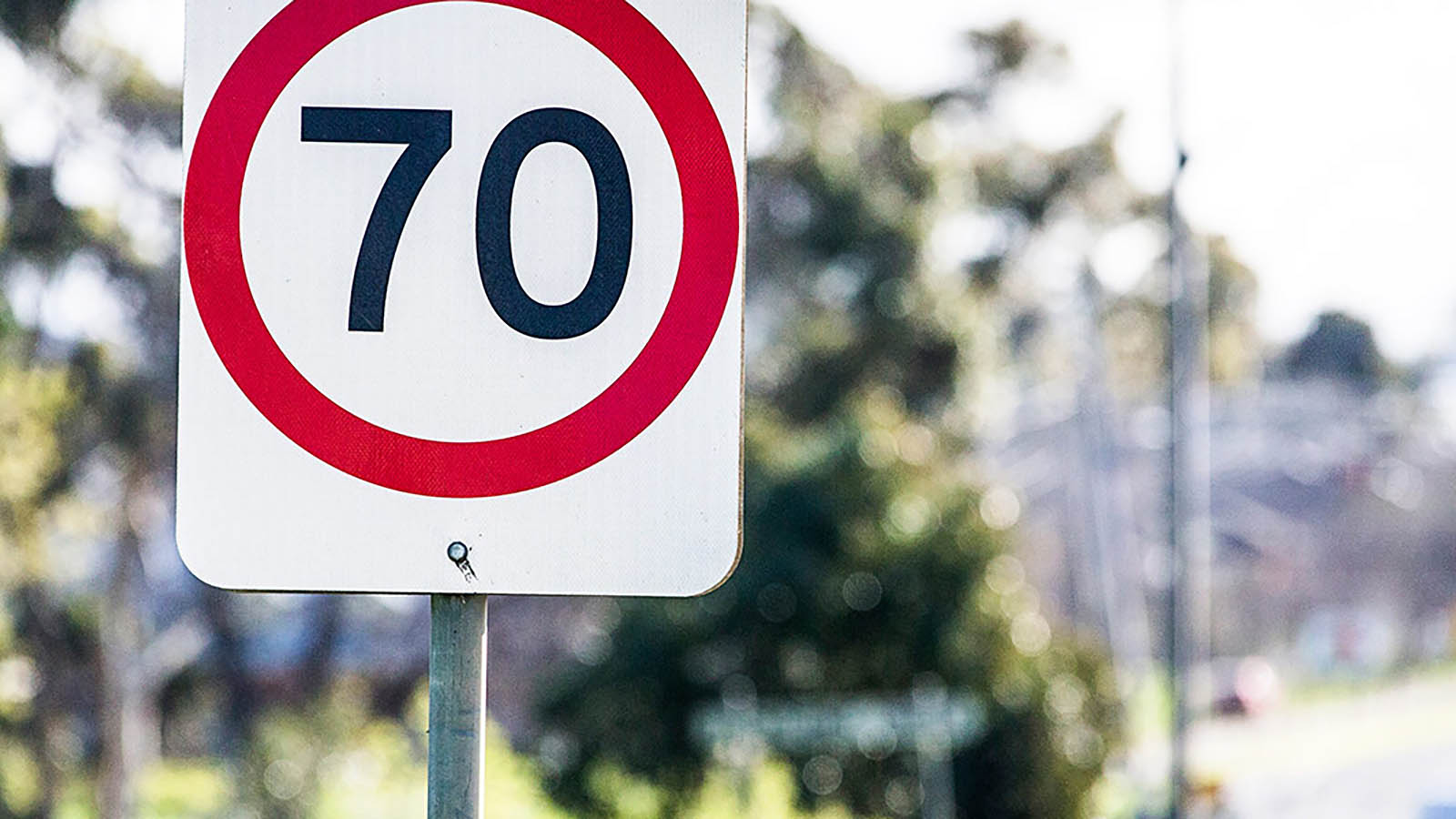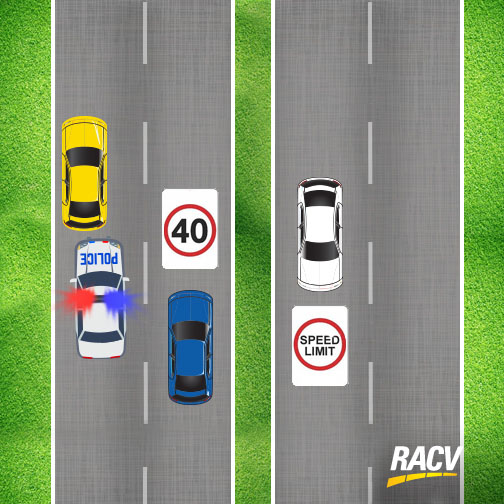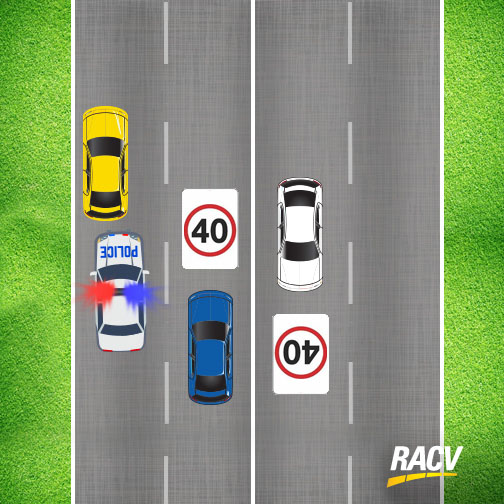Speed limits indicate the maximum speed allowed, not the speed you should necessarily travel at. You should always drive for the conditions, such as in extreme weather conditions or in areas of reduced visibility.

Speed limits and speed zones
Understand Victorian speed limits and why they exist
Thank you for contacting us
Your reference number is
We'll contact you within 72 hours and may ask for this reference number.
Speed limits and speed zones
Victorian speed limits
Speed signs reflect the maximum speed allowed, so you must travel at or below the speed shown. Some drivers may be subject to lower speed limits, including some heavy vehicles which are restricted to 100km/h and some learner drivers from outside Victoria.
When you see a speed limit sign, that limit applies for the entire length of road following that sign until you reach a sign with another speed limit, an ‘end speed limit’ sign, or the end of a road if the road ends at a T-intersection or dead end. Speed limits apply in a 'road related area' which includes car parks and any area that is open to the public for driving, riding or parking, or is for use by cyclists or animals.
In areas where there is no speed limit sign, default speed limits apply.
- In built up areas, the default speed limit is 50km/h.
- For country roads, the default speed is 100km/h.
Refer to rules 20, 21, 22, 24 and 25 of the Victorian Road Safety Road Rules 2017.
The rules about driving below the speed limit relate to unreasonably obstructing the path of other road users, rather than stating a minimum speed.
A driver is not considered to be unreasonably obstructing another road user if the driver is stopped in traffic; or if the driver is driving more slowly than the other vehicles (unless the driver is driving abnormally slow in the circumstances).
The rules provide an example of a driver driving abnormally slow:
“A driver driving at a speed of 20 kilometres per hour on a length of road to which a speed limit of 80 kilometres per hour applies when there is no reason for the driver to drive at that speed on the length of road”.
The key reason to this example is “when there is no reason” for the slower speed. Under adverse conditions, such as rain, at night, or areas with high pedestrian activity, it is often necessary to drive at a speed that is slower than the posted speed limit.
For more information see rule 125 of the Victorian Road Safety Road Rules 2017.
A regulatory sign is a white sign that has black text in a red circle. It’s illegal to disobey these signs.
An advisory sign is a yellow sign with black text. These provide advice on the appropriate speed in an area.
Special speed limits
Victoria is currently experiencing a construction boom, so it’s likely you’ll come across a lot of speed signs on your daily commute.
Speed limits change around road works to keep motorists and workers safe. They account for things like:
- large machinery
- narrowed roads
- temporarily removed line markings
- closed lanes.
Here are the key things to remember:
- Keep an eye out for advisory signs warning of changed conditions
- Obey the regulatory signs on the road, regardless of whether workers are visible or not
- If you notice an issue at a roadworks site, contact VicRoads on 13 11 70 or your local council (see our advice on: reporting a problem)
When driving near a Victorian school, lower speed limits apply for the safety of children crossing the roads. The school speed limit and type of sign you see will depend on the usual speed limit of the road adjacent to the school.
These speed limits apply during the following times on school days:
- 8:00am - 9:30am
- 2:30pm - 4:00pm
School term dates and holidays are publishd by the Victorian Department of Education and Training. Within these blocks of dates, 'school day' speed limits apply every day except Saturdays, Sundays and local public holidays, unless signs indicate otherwise.
Keep in mind:
- Reduced limits apply on a designated school day even if the school is closed for a 'student free day' or other activity, or if it is a school with different term dates. School speed zones may apply locally on weekends or public holidays if signs indicate this on the day.
- ‘School days’ may also apply to parking around schools where signs indicate that the parking restriction applies on school days (e.g. P 5min school days).
For more information see rules 20, 23 and 317A of the Victorian Road Safety Road Rules 2017.
When emergency or enforcement vehicles are displaying red, blue or magenta lights, or sounding their alarm, drivers must:
- safely approach the scene at a speed that allows you to easily stop if needed before passing the vehicle
- give way to any emergency or enforcement worker on foot in the vicinity
- not drive past or overtake the vehicle at a speed of more than 40km/h
- not increase speed until you’re a sufficient distance past the vehicle and not cause danger to any worked in the vicinity.
The rule applies despite any other road rule and applies regardless of whether the incident is deemed an emergency or not.
The rule applies to all road types including freeways, with an exception for divided roads.
On divided roads with a median strip, the rule only applies to lanes of traffic on the same side of the road as the emergency/enforcement vehicle.
If the emergency/enforcement vehicle is in a service road, the rule applies to drivers on the main carriageway.


What about on high-speed roads?
The rule requires you to safely approach and depart the scene at a speed that allows you to stop if required. VicRoads advise that this is necessary to avoid sudden speed changes and ensure drivers could reasonably comply with a 40km/h limit safely, especially on high-speed roads. The 40km/h limit only applies at the point of passing the emergency/enforcement vehicle.
What are some examples of emergency and enforcement vehicles?
Examples include: Police, Ambulance, Fire Services, State Emergency Service and heavy vehicle enforcement vehicles which have magenta flashing lights, such as a VicRoads Transport Safety Service vehicle
What is a slow-moving vehicle?
The rule doesn't provide a definition of 'slow-moving'. The example given by VicRoads of a vehicle that is moving slowly is "less than 10km/h", for example "a fire truck extinguishing roadside spot fires is an example of a slow-moving emergency vehicle".
For more information see rule 79A of the Victorian Road Safety Road Rules 2017.
Refresh your knowledge of the Victorian road rules
The summaries RACV provide on Victorian road rules are based on the Victorian Road Safety Road Rules 2017. We make sure to reference the exact rule where possible. When reading, keep in mind that we’re providing general information, not legal advice. If you’re looking for specific questions on any legal matter, consult with a lawyer for help.